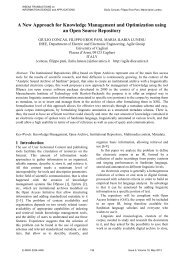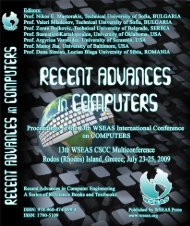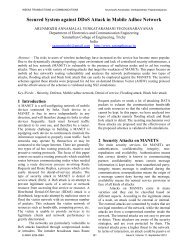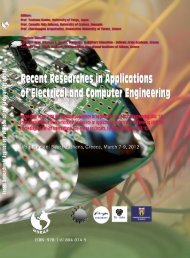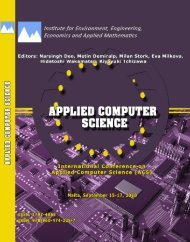RECENT ADVANCES in CIRCUITS, SYSTEMS, SIGNAL ... - Wseas.us
RECENT ADVANCES in CIRCUITS, SYSTEMS, SIGNAL ... - Wseas.us
RECENT ADVANCES in CIRCUITS, SYSTEMS, SIGNAL ... - Wseas.us
Create successful ePaper yourself
Turn your PDF publications into a flip-book with our unique Google optimized e-Paper software.
<strong>RECENT</strong> <strong>ADVANCES</strong> <strong>in</strong> <strong>CIRCUITS</strong>, <strong>SYSTEMS</strong>, <strong>SIGNAL</strong> and TELECOMMUNICATIONS<br />
Plenary Lecture 1<br />
Real-Time & In-Service Optical Channel Qualification and Channel Protection <strong>in</strong><br />
Intelligent Optical Networks<br />
Professor Stamatios Kartalopoulos<br />
Williams Professor <strong>in</strong> Telecommunications Network<strong>in</strong>g<br />
The University of Oklahoma<br />
USA<br />
Email: Kartalopoulos@ou.edu<br />
Abstract: Fiber-based optical networks transport an aggregate data rate that exceeds Tbps. The optical technology<br />
that makes this possible is known as dense wavelength division multiplex<strong>in</strong>g (DWDM). Beca<strong>us</strong>e of this humongo<strong>us</strong><br />
data rate, the performance of optical channels needs to be monitored cont<strong>in</strong>uo<strong>us</strong>ly <strong>in</strong>-service and <strong>in</strong>-real time. One of<br />
the key performance metrics is the Bit Error Performance (BER), which currently is measured by <strong>us</strong><strong>in</strong>g bit error<br />
detect<strong>in</strong>g correct<strong>in</strong>g codes (EDC) that are embedded <strong>in</strong> the signal of the <strong>in</strong>formation channel. However, EDCs,<br />
although <strong>in</strong>dispensable for their bit error correct<strong>in</strong>g ability, require many frames of <strong>in</strong>formation to provide a good<br />
statistical BER value for each channel. When the BER exceeds a threshold value, then the system undergoes<br />
channel equalization or channel protection, which is time consum<strong>in</strong>g and costly. In this talk, we describe a statistical<br />
method based on which we estimate the performance parameters of all <strong>in</strong>com<strong>in</strong>g communication channels <strong>in</strong> realtime<br />
and <strong>in</strong>-service. This method provides the estimation of BER, SNR, NF, Q, and m<strong>in</strong>-max signal levels of current<br />
and previo<strong>us</strong> values. In addition, we describe the realization of the method with a simple CMOS circuit, we describe<br />
the benefits of the method, compare with well-established methods and we describe its applicability to multiple<br />
channel equalization and channel protection.<br />
Brief Biography of the Speaker:<br />
Stamatios V. Kartalopoulos, PhD, is currently the Williams Professor <strong>in</strong> Telecommunications Network<strong>in</strong>g at the<br />
University of Oklahoma. His research emphasis is on optical communication networks (FSO, long haul and FTTH),<br />
optical technology <strong>in</strong>clud<strong>in</strong>g optical metamaterials, and optical communications security <strong>in</strong>clud<strong>in</strong>g quantum<br />
cryptography and chaotic functions. Prior to this, he was with Bell Laboratories where he def<strong>in</strong>ed, led and managed<br />
research and development teams <strong>in</strong> the areas of DWDM networks, SONET/SDH and ATM, Cross-connects,<br />
Switch<strong>in</strong>g, Transmission and Access systems. He has received the President’s Award and many awards of<br />
Excellence.<br />
He holds n<strong>in</strong>eteen patents <strong>in</strong> communications networks, and has published more than two hundred scientific papers,<br />
ten reference textbooks <strong>in</strong> advanced fiber optic communications and security, and has contributed several chapters to<br />
other books.<br />
He has been an IEEE and a Lucent Technologies Dist<strong>in</strong>guished Lecturer and has lectured at universities, NASA and<br />
conferences <strong>in</strong>ternationally. He has been keynote speaker of major <strong>in</strong>ternational conferences, has moderated<br />
executive forums, has been a panelist of <strong>in</strong>terdiscipl<strong>in</strong>ary panels, and has organized symposia, workshops and<br />
sessions at major <strong>in</strong>ternational communications conferences.<br />
Dr Kartalopoulos is an IEEE Fellow, chair and founder of the IEEE ComSoc Communications & Information Security<br />
Technical Committee, member at large of IEEE New Technologies Directions Committee, series editor of IEEE<br />
Press/Wiley, and has served editor-<strong>in</strong>-chief of IEEE Press, chair of ComSoc Emerg<strong>in</strong>g Technologies and of SPCE<br />
Technical Committees, Area-editor of IEEE Communications Magaz<strong>in</strong>e/Optical Communications, member of IEEE<br />
PSPB, and VP of IEEE Computational Intelligence Society.<br />
ISSN: 1790-5117 14 ISBN: 978-960-474-152-6




